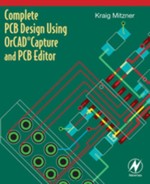Overview of the Design Flow
Regardless of which type of board is made, certain steps must be executed in the design flow process. The following is an outline of the process.
1. Initial design concept and preparation:
A. Generate initial drawings.
B. Collect data sheets.
C. Take inventory of packaging and footprint needs.
D. Search through the Capture libraries to find the parts. For any parts that are unavailable, construct the parts using the Capture Part Editor or the PSpice Model Editor.
2. Set up the design project in Capture:
A. Draw the schematic (placing and connecting parts).
B. Perform an annotation to clean up numbering.
C. Make sure multipart packages are properly utilized.
D. Make sure global power nets are properly connected.
E. Assign related components to groups (“rooms”) to aid in part placement in PCB Editor.
F. Perform a Capture design rule check (DRC) to verify that the circuit schematic has no issues. Correct any errors and repeat DRCs as needed.
G. Generate a bill of materials to identify PCB assigned and missing footprints.
H. Search through the PCB Editor libraries to find and assign footprints. For any footprints that are unavailable, obtain the data sheets for recommended land patterns and design the footprints using PCB Editor and the Padstack Designer.
I. Generate a PCB Editor netlist and open the board design.
3. Define the board requirements:
A. Board dimensions and mounting hole locations.
B. Part placement considerations (height restrictions, assembly method).
C. Noise and shielding requirements.
D. Component mounting technology (SMT, THT).
E. Trace width and trace spacing requirements.
F. Required vias and fan-outs (size and tenting, etc.).
G. Number of Power/Ground planes and Routing layers.
4. Basic board setup:
A. Physical:
a. Create the board outline.
b. Place mounting holes.
c. Define part and routing restriction areas.
d. Add dimension documentation (optional).
B. Preliminary parts placement:
a. Use Search and Place tools to place selected parts and groups.
b. Perform a board DRC to check for footprint and placement problems.
C. Layer setup:
a. Set up Power and Ground planes.
b. Set up Routing layers.
c. Assign ground and power nets to Plane layers.
d. Define thermal relief parameters.
e. Set which vias to use for fan-outs, routing vias, jumpers, and the like.
f. Perform a DRC to check for layer problems.
D. Final parts placement:
a. Make sure spacing rules are not violated.
b. If using split or moated Plane layers, make sure parts are placed accordingly.
c. Check orientation of polarized components (caps, diodes, etc.).
5. Preroute specific nets using manual and restricted autorouting:
A. Perform power and ground fan-outs.
B. Preroute critical nets manually.
C. Perform DRC to make sure that no errors have occurred. Fix errors.
6. Autorouting:
A. Set up the autorouter.
B. Run the autorouter.
C. Perform DRC to make sure that no errors have occurred. Fix errors.
7. Finalizing the design:
A. Postrouting inspection:
a. Sharp (acute) angles.
b. Long parallel traces (cross-talk issues).
c. Via locations.
d. Silk-screen markings.
B. Board cleanup:
a. Unroute and then reroute problem traces.
b. Perform a final DRC.
C. Synchronization with Capture (back annotation).
A detailed example of how to create the artwork and NC files for the design is included in
Chapter 10
.
..................Content has been hidden....................
You can't read the all page of ebook, please click here login for view all page.
